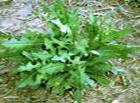Scientific Classification:
|
Other Common Names:
The other common names for the herb wild lettuce are Bitter lettuce, Opium Lettuce, Compass Plant, Horse Thistle, Prickly Lettuce, Wild Lettuce and Wild Opium.
History



Description
Wild lettuce is s biennial plant is unbranched and 3-8' tall. The central stem is round and smooth, light green or reddish green and often glaucous. The alternate leaves are light green to dark green, Wild Lettuce in Woodland Opening sometimes with purple edges or a yellowish cast. They are up to 10" long and 3" across. The largest leaves have deep pinnate lobes, while the smaller leaves have shallow pinnate lobes or none. A typical leaf is wider at the base than at its tip, and clasps the stem. Occasionally it has widely spaced small teeth along the margin and short fine hairs along the mid-vein on the underside. The leaf surface can be shiny or dull. The small dandelion-like flowers occur in a narrow panicle at the apex of the plant. They are yellow or slightly orange. The flowers are numerous, small, about 1\4 in. across, involucre, cylindrical, rays pale yellow; followed by abundant, soft, bright white pappus; the heads growing in loose, branching, terminal clusters. There is no noticeable floral scent. The rough, black fruit is oval, with a broad wing along the edge, and prolonged above into a long, white beak carrying silvery tufts of hair. The whole plant is rich in a milky juice that flows freely from any wound. This has a bitter taste and a narcotic odour. When dry, it hardens, turns brown, and is known as lactucarium.The root system consists of a thick deep taproot. There is white latex in the root, leaves, and stems.Range
Wild lettuce is widely distributed in Georgia, westward to Arkansas, north to the British Possessions. It is common that wild lettuce is a common plant that occurs in almost all counties of Illinois.Habitat
Habitats include moist to slightly dry black soil prairies, clay prairies, gravel prairies, openings in woodlands, thickets, savannas, lake borders and riverbanks, limestone glades, fence rows, pastures and abandoned fields, powerline clearances, areas along railroads and Close-Up of Lower Leaf roadsides, vacant lots, and miscellaneous waste areas. This plant is more common in degraded prairies and disturbed habitats, although it can also be found in high-quality habitats.Cultivation
Wild lettuce is a commonly growing plant in all parts of Europe and is found in abundance in the open areas and along the pavements. The herb is commercially cultivated in countries like Austria, France, Germany and Scotland. The herb also grows in waste lands and along the embankments. The herb is collected in summer between July and August when the plant is in blossom. The preference is full or partial sun, and moist to slightly dry conditions. Growth is best in fertile loamy soil, although poor gravelly soil and clay-loam are also tolerated. This plant varies considerably in size depending on growing conditions. It is not bothered significantly by foliar disease, and is easy to grow.Do not cover seeds - just press them into moist soil and water to germinate in 7-14 days at 70F.Keeping the soil covered with plastic will help hold in moisture, but watch for fungus in that case. This is a biennial, which means in the first year it will make a rosette of leaves, and in the second year the flower stalk will shoot up to 6 ft. and produce seeds (but if you're lucky, it will make seeds the first year). This plant likes rich, moist soil and reseeds so readily that it is considered a weed in many areas.
Flowering Season
The blooming period of wild lettuce occurs during late summer or early fall, and lasts about 3 weeks.
The common pests affecting wild lettuce are the aphids, hoppers, whiteflies, bugs, thrips, flies, beetles, caterpillars and diseases like bottom rot and downy mildew.
Parts Used
 | The leaves and the latex are the most commonly used parts of the wild lettuce for its medicinal and commercial purposes. |
Medicinal Applications

- Wild lettuce is a sedative, helps to induce sleep, and calm restlessness and anxiety.
- In nursing mothers it enhances lactation or milk production by the mammary glands.
- Many herbal medicine practitioners also recommended the use of wild lettuce as a diuretic as also a lotion to treat chapped skin.
- The herb is recommended to treat nervousness and excitement in kids.
- Wild lettuce is useful in restraining the sexual drive.
- It is used as a pain killer, for Insomnia, nervousness, hysteria, muscle spasms, colic pains, painful menstruation, bothersome coughs, and painful digestion.
- Wild lettuce has also been known to be effective in calming the throat and chest and reducing coughs.
Commercial Applications

- The plant’s high latex content led to its experimental use as an alternative source of rubber.
- The herb is used as an ingredient for lotions to cure skin disorders owing to sunburn and coarseness.
Quotes from Religious Inscriptions
Herodotus says lettuce was eaten as a salad in 550 B.C.; in Pliny's time it was cultivated, and even blanched, so as to be had at all seasons of the year by the Romans. Among the privy-purse expenses of Henry VIII is a reward to a certain gardener for bringing "lettuze" and cherries to Hampton Court. In the 16th century, Gerard said this of wild lettuce: " it procures sleep, asswages Paine, moves the courses in women, and is drunke against the stingings of scorpions and biting of spiders.Folklore and Myths
Pagans use wild lettuce as an incense aid for divination, especially when working with darker deities.


